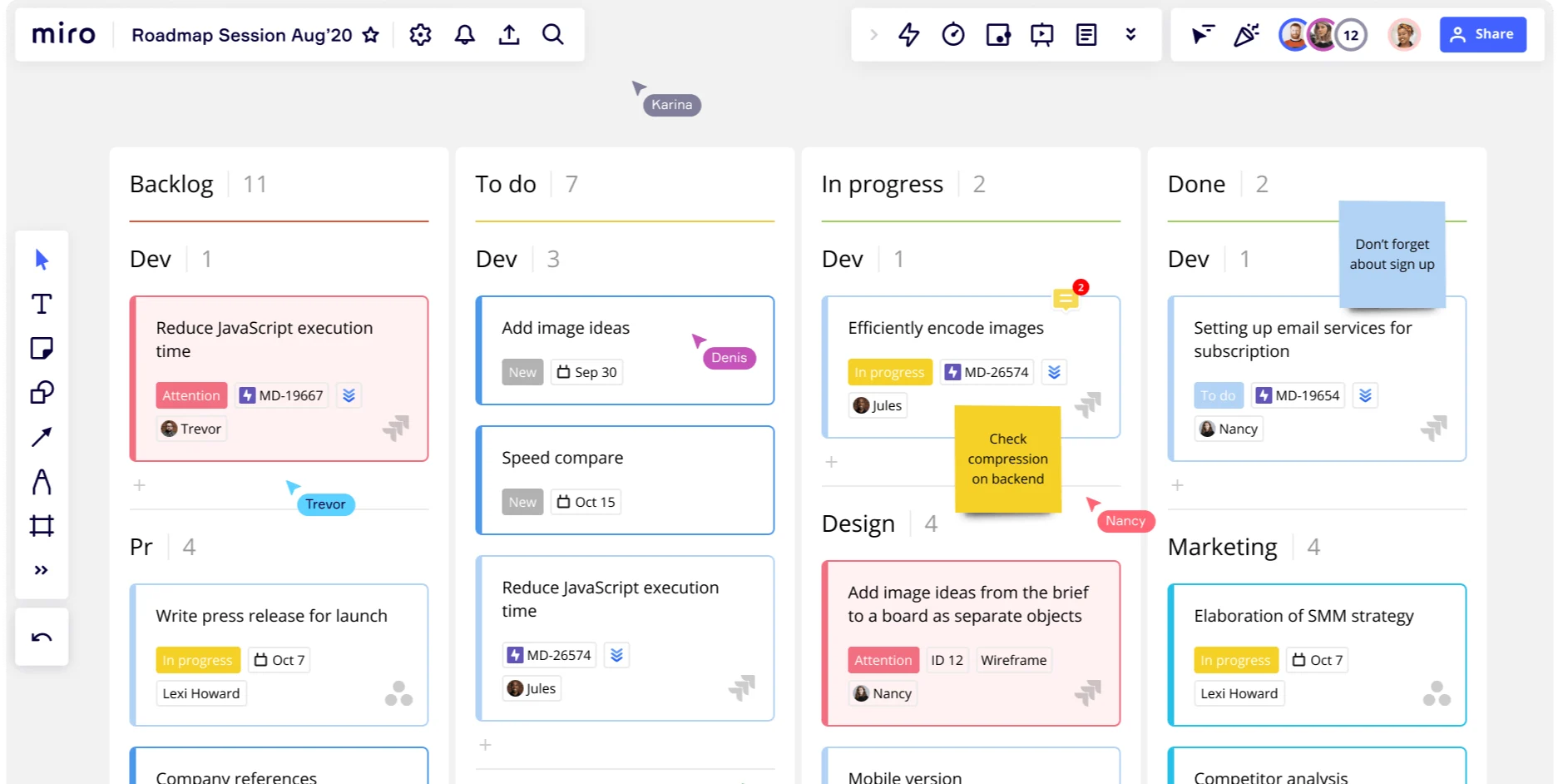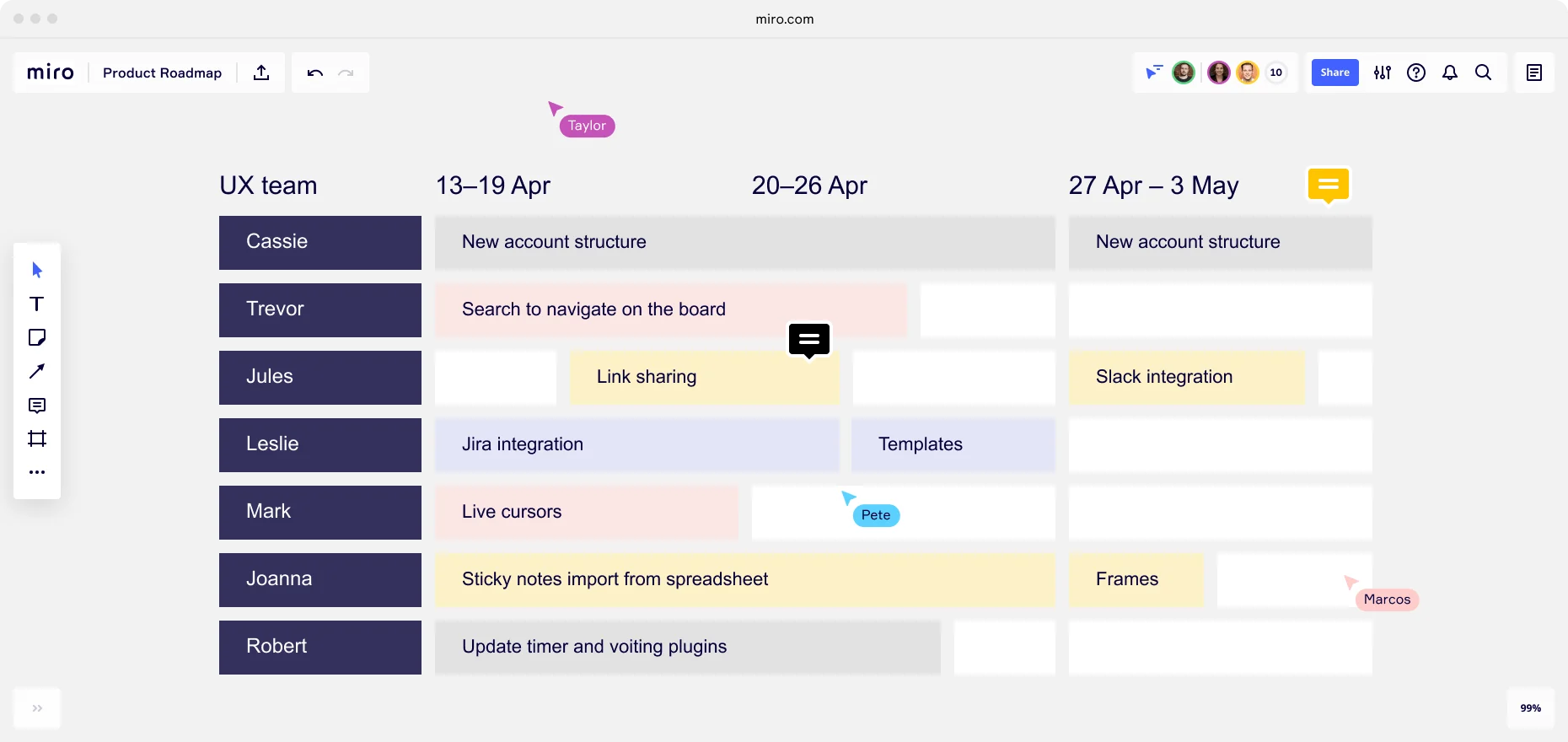
Product Backlog vs. Roadmap

Summary
In this guide, you will learn:
- Product backlog vs. roadmap: focus and detail.
- Time horizons: short-term sprints to long-term strategy.
- Backlog feeds and shapes the roadmap.
- Aligning backlog and roadmap throughout development.
- Roles in communicating priorities.
- Roadmap formats and implications of timeline-based vs. other approaches.
Try Miro now
Join thousands of teams using Miro to do their best work yet.
Key differences between product backlogs and product roadmaps
Effective management of product requirements is a critical aspect of successful product development. Product backlogs and product roadmaps play vital roles in this process. Properly managing product requirements ensures that the team stays focused on delivering customer value, meeting business objectives, and adapting to changing market needs.
A well-organized product backlog allows product teams to capture and prioritize all the features, enhancements, and fixes needed for the product. By maintaining a well-defined and up-to-date backlog, teams can efficiently allocate resources, minimize risks, and make informed decisions about what to work on next.
On the other hand, a thoughtfully crafted product roadmap provides a strategic vision and direction for the product's development over time. It outlines the major milestones, release schedules, and high-level initiatives. This clarity helps stakeholders understand the product's future direction and align their expectations accordingly.
By managing product requirements effectively, development teams can optimize their productivity, enhance collaboration among stakeholders, and ultimately deliver valuable products that meet market demands.
Understanding product backlogs
The product backlog serves as the master list of all work items that need to be completed for a product. It comprises several key components, each contributing to its efficiency.
User stories capture features from an end-user perspective, while epics group related stories together for better planning. Tasks represent the granular units of work required to complete a user story, and bugs highlight issues that need resolution.
Prioritization, estimation, and managing dependencies are also essential elements, ensuring the team works on the most valuable tasks first and maintains a smooth flow of development.

Understanding product roadmaps
A product roadmap is a strategic document that provides a clear visual representation of a product's vision, direction, and progress over time. At its core lies a compelling vision statement, setting the purpose and goal for the product.
The roadmap outlines key themes, initiatives, and features that align with the product's vision, providing stakeholders with a clear sense of its development progress and future direction. Timelines and milestones act as markers for tracking progress, while risk assessment and market analysis help anticipate challenges and adapt the product's strategy accordingly.
By focusing on the big picture, a product roadmap empowers the team to prioritize effectively and deliver a successful product.

Key differences between the product backlog and roadmap
While both backlogs and roadmaps are essential artifacts in product development, they serve distinct purposes throughout the product lifecycle.
Focus and granularity
The first significant difference between the product backlog and roadmap lies in their focus and level of detail.
Product backlog: The product backlog primarily focuses on detailing individual user stories, tasks, and bugs. It is highly granular, capturing specific and actionable items that the development team needs to work on during each sprint or iteration. This granularity allows for precise planning and tracking of progress on a day-to-day basis.
Product roadmap: Conversely, the product roadmap takes a high-level and strategic perspective. It outlines major themes, initiatives, and feature releases, providing a broader vision of the product's development trajectory over time. The roadmap's focus is on communicating the product's direction to stakeholders and aligning the team's efforts with long-term goals.
Time horizon
Another key difference lies in the time horizon of the two artifacts.
Product backlog: The product backlog typically covers a shorter time frame, often spanning a few sprints (usually a few weeks to a month). It focuses on immediate development priorities and is regularly refined and reprioritized to accommodate changing requirements.
Product roadmap: On the other hand, the product roadmap has a longer time horizon, often covering several months to a year or more. It provides a strategic outlook of the product's evolution, allowing stakeholders to plan and allocate resources for upcoming releases and strategic initiatives.
Stakeholder communication
The manner in which these artifacts are used for stakeholder communication is also different.
Product backlog: The product backlog is primarily a tool for internal communication within the development team. It helps team members understand the tasks at hand, align on priorities, and collaborate effectively during the development process.
Product roadmap: Roadmaps serve as a crucial communication tool for external stakeholders, including executives, customers, investors, and marketing teams. It communicates the product's vision, upcoming features, and the planned timeline. This transparency helps manage expectations and gain support for the product's development.
Role in decision-making
Product backlogs and roadmaps play distinct roles in decision-making and planning.
Product backlog: The backlog heavily influences the day-to-day decision-making process for the development team. It guides the team on what to work on next, based on priority, dependencies, and capacity.
Product roadmap: Conversely, a roadmap informs higher-level decisions and strategic planning. It aids in defining the product's long-term objectives, aligning those objectives with the organization's goals, and making informed decisions about resource allocation and market positioning.
Integrating backlogs and roadmaps in product development
Integrating the product backlog and roadmap is crucial for ensuring a cohesive and successful product development process. These two artifacts work in tandem to guide the team from conception to execution, aligning the short-term tasks with the long-term strategic objectives of the product.
By seamlessly connecting these elements, development teams can maintain focus, optimize resource allocation, and effectively deliver value to customers and stakeholders. Let's explore how the product backlog feeds into the product roadmap and the strategies to ensure consistency and adaptability between the two.
How the product backlog feeds into the product roadmap
The product backlog serves as the foundation for the product roadmap. As the development team prioritizes and refines tasks, user stories, and bugs in the backlog, the most critical and valuable items find their way into the roadmap. These items are transformed into high-level themes, initiatives, and feature releases that align with the product's vision and strategic goals.
The product backlog acts as a reservoir of ideas and requirements, enabling the team to pull from this backlog and populate the roadmap with the most impactful and feasible initiatives. As development progresses and feedback is gathered, the backlog continuously evolves, providing a continuous flow of input to shape the roadmap and adapt to changing market demands.
Ensuring consistency between the two
Maintaining consistency and adaptability between the product backlog and roadmap is essential for successful product development. Here are some strategies to achieve this integration effectively:
- Regular alignment meetings: Hold regular meetings between the development team and product stakeholders to align the backlog items with the strategic goals outlined in the roadmap. These sessions enable stakeholders to provide feedback on prioritization and ensure the backlog aligns with the product's direction.
- Prioritization and refinement: Continuously prioritize and refine the product backlog based on changing market conditions, customer feedback, and internal assessments. This process ensures that the most valuable and feasible items are carried over to the product roadmap, reflecting the evolving needs of the product.
- Open communication: Foster open communication channels between the development team and stakeholders. Encourage regular updates and discussions about the roadmap's progress and any changes made to the backlog. This transparency ensures everyone is on the same page and can adapt to new information efficiently.
- Flexibility and iteration: Embrace flexibility and continuous iteration in both artifacts. Acknowledge that plans may change based on feedback, market shifts, or unforeseen circumstances. Regularly update the roadmap and adjust the backlog accordingly to stay responsive to emerging opportunities and challenges.
- Alignment with business objectives: Ensure that the product backlog and roadmap are aligned with the broader business objectives and goals. This alignment ensures that the product development efforts remain focused on delivering value to the organization and its customers.
By integrating the product backlog and roadmap effectively and promoting consistency and adaptability, development teams can create a well-aligned and agile product development process, driving the product's success in a dynamic market landscape.
Author: Miro Team
Last update: October 14, 2025